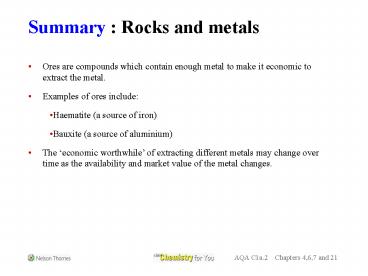New Chemistry for You : Summary PowerPoint PPT Presentation
1 / 9
Title: New Chemistry for You : Summary
1
Summary Rocks and metals
- Ores are compounds which contain enough metal to
make it economic to extract the metal. - Examples of ores include
- Haematite (a source of iron)
- Bauxite (a source of aluminium)
- The economic worthwhile of extracting different
metals may change over time as the availability
and market value of the metal changes.
AQA C1a.2 Chapters 4,6,7 and 21
2
Summary Rocks and metals
- The Reactivity Series lists metals in order of
reactivity. - A more reactive metal can displace a less
reactive metal from its compounds. For
examplecopper oxide zinc ? zinc oxide
copper - Metals less reactive than carbon can be extracted
from their ores by reduction with carbon. For
example - carbon iron oxide ? carbon dioxide iron
AQA C1a.2 Chapters 4,6,7 and 21
3
Summary Rocks and metals
- The way we extract a metal from its ore depends
on its place in the Reactivity Series. The more
reactive a metal is, the harder it is to extract. - Iron oxide is reduced to iron in a Blast furnace.
- The iron produced in the furnace contains 90
pure iron, the impurities present make the iron
brittle and this restricts its use. - Most of the iron produced from the Blast furnace
is then changed into steel. Steel is an alloy of
iron, carbon and other metals.
AQA C1a.2 Chapters 4,6,7 and 21
4
Summary Rocks and metals
- Alloys are often stiffer, stronger and harder
than the pure metal itself. These properties
relate to specific uses of alloys. Examples of
alloys include - Brass
- Bronze
- Steel (low carbon and high carbon)
- Stainless steel
- Gold, copper and aluminum may also be alloyed to
make them harder.
AQA C1a.2 Chapters 4,6,7 and 21
5
Summary Rocks and metals
- The Transition metals are found in the central
block of Periodic table. They have properties
typical of other metals, they - are hard and dense, with high melting points
- are less reactive than Group 1 or Group 2 metals
- form coloured compounds
- can form compounds with more than one formula,
for example, iron(II) oxide, and iron(III) oxide. - are important catalysts in industry.
- can be hammered or bent into shape
- are good conductors of heat and electricity
AQA C1a.2 Chapters 4,6,7 and 21
6
Summary Rocks and metals
- Copper is a very useful transition metal. The
properties of copper make it especially useful
for electrical wiring and plumbing. - Copper is purified by a process called
electrolysis. - Since the supply of copper rich ores is limited,
research is being undertaken to enable copper to
be extracted from low grade ores. This will also
limit the environmental impact of traditional
mining methods.
AQA C1a.2 Chapters 4,6,7 and 21
7
Summary Rocks and metals
- Aluminium and titanium are metals with low
densities, they are also corrosion resistant. - When alloyed, aluminum is useful for making
aircraft frames, step-ladders, drinks cans and
food containers. - Titanium alloys may be used in turbine engine
parts, surgical implants, heat exchanges and
rocket motor casings. - Aluminium and titanium cannot be extracted from
their ores using carbon. The methods used to
extract these metals however, are expensive.
AQA C1a.2 Chapters 4,6,7 and 21
8
Summary Rocks and metals
- Steel and aluminium are two of the most common
metals used in the UK . - Metals can be recycled indefinitely without
loosing any of their properties. They make up
around 8 of the average household dustbin. - If metals are recycled, our limited resources
will last longer and the effects on the
environment will be reduced. - Recycling metals, compared to extracting them,
will save considerable energy costs!
AQA C1a.2 Chapters 4,6,7 and 21
9
(No Transcript)

